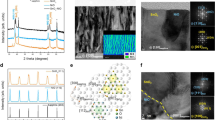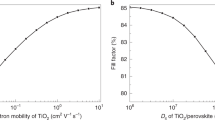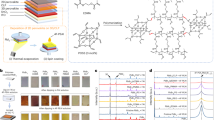Abstract
Many properties provided by supramolecular chemistry, nanotechnology and catalysis only appear in solids exhibiting large surface areas and regular porosity at the nanometre scale1,2,3,4. In nanometre-sized particles, the ratio of the number of atoms in the surface to the number in the bulk is much larger than for micrometre-sized materials, and this can lead to novel properties. Here we report the preparation of a hierarchically structured mesoporous material from nanoparticles of CeO2 of strictly uniform size. The synthesis involves self-assembly of these 5-nm CeO2 pre-treated nanoparticles in the presence of a structure directing agent (poly(alkylene oxide) block polymer). The walls of this hexagonal structured CeO2 material are formed from the primary nanoparticles. The material possesses large pore volumes, high surface areas, and marked thermal stability, allowing it to be easily doped after synthesis whilst maintaining textural and mechanical integrity. It also exhibits a photovoltaic response, which is directly derived from the nanometric particle size—normal CeO2 does not show this response. We have constructed operational organic-dye-free solar cells using nanometric ceria particles (in both mesostructured or amorphous forms) as the active component, and find efficiencies that depend on the illuminating power.
This is a preview of subscription content, access via your institution
Access options
Subscribe to this journal
Receive 12 print issues and online access
$259.00 per year
only $21.58 per issue
Buy this article
- Purchase on Springer Link
- Instant access to full article PDF
Prices may be subject to local taxes which are calculated during checkout






Similar content being viewed by others
References
Cheetham, A.K., Ferey, G. & Loiseau, T. Open-framework inorganic materials. Angew. Chem. Int. Edn 38, 3268–3292 (1999).
Foerster, S. & Antonietti, M. Amphiphilic block copolymers in structure-controlled nanomaterial hybrids. Adv. Mater. 10, 195–217 (1998).
Forster, S. & Plantenberg, T. From self-organizing polymers to nanohybrid and biomaterials. Angew. Chem. Int. Edn 41, 688–714 (2002).
Klok, H.-A. & Lecommandoux, S. Supramolecular materials via block copolymer self-assembly. Adv. Mater. 13, 1217–1229 (2001).
Trovarelli, A. Catalytic properties of ceria and CeO2-containing materials. Catal. Rev. Sci. Eng. 38, 439–520 (1996).
Flytzani-Stephanopoulos, M. Nanostructured cerium oxide “Ecocatalysts”. MRS Bull. 26, 885–889 (2001).
Corma, A. & López-Nieto, J.M. . in Handbook on the Physics and Chemistry of Rare Earths Vol. 29, (eds Gschneider, K. A. Jr & Eyring, L.) Ch. 185, 269–313 (Elsevier, Amsterdam, 2000).
Steele, B.C.H. Appraisal of Ce1−yGdyO2−y/2 electrolytes for IT-SOFC operation at 500 °C. Solid State Ionics 129, 95–110 (2000).
Murray, E.P., Tsai, T. & Barnett, S.A. A direct-methane fuel cell with a ceria-based anode. Nature 400, 649–651 (1999).
Terribile, D., Trovarelli, A., Llorca, J., De Leitenburg, C. & Dolcetti, G. The synthesis and characterization of mesoporous high-surface area ceria prepared using a hybrid organic/inorganic route. J. Catal. 178, 299–308 (1998).
Lyons, D.M., Ryan, K.M. & Morris, M.A. Preparation of ordered mesoporous ceria with enhanced thermal stability. J. Mater. Chem. 12, 1207–1212 (2002).
Bach, U. et al. Solid-state dye-sensitized mesoporous TiO2 solar cells with high photon-to-electron conversion efficiencies. Nature 395, 583–585 (1998).
Kalyanasundaram, K. & Gratzel, M. in Optoelectronic Properties of Inorganic Compounds 169–194 (Plenum, New York, 1999).
Durrant, J.R., Tachibana, Y., Moser, J.E., Gratzel, M. & Klug, D.R. Interfacial electron transfer in dye sensitized nanocrystalline TiO2 films. Spring. Ser. Chem. Phys. 62, 433–434 (1996).
Hagfeldt, A. & Gratzel, M. Molecular photovoltaics. Acc. Chem. Res. 33, 269–277 (2000).
Orel, Z. & Orel, B. Optical properties of pure and mixed CeO2/SnO2 thin films. Phys. Status Solidi B 186, K33–K36 (1994).
Masui, T., Yamamoto, M., Sakata, T., Mori, H. & Adachi, G. Synthesis of BN coated CeO2 fine powder as a new UV blocking material. J. Mater. Chem. 10, 353–357 (2000).
Bueno, R.M., Martinez-Duart, J.M., Hernandez-Velez, M. & Vazquez, L. Optical and structural characterization of r.f. sputtered CeO2 thin films. J. Mater. Sci. 32, 1861–1865 (1997).
Patsalas, P., Logothetidis, S., Sygellou, L. & Kennou, S. Structure-dependent electronic properties of nanocrystalline cerium oxide films. Phys. Rev. B 68, 035104 (2003).
Liu, G., Rodriguez, J.A., Hrbek, J., Dvorak, J. & Peden, C.H.F. Electronic and chemical properties of Ce0.8Zr0.2O2(111) surfaces: photoemission, XANES, density-functional, and NO2 adsorption studies. J. Phys. Chem. B 105, 7762–7770 (2001).
Li, L., Lu, L. & Xie, H. Electrolytic domain boundary between ionic and electronic conduction of doped ceria. J. Mater. Sci. Technol. 14, 451–456 (1998).
Acknowledgements
We thank Comisión Interministerial de Ciencia y Tecnología, CICYT (MAT2003-07945-C02-01), for financial support, and A. Luque and I. Tobias of the Instituto de Energía Solar de Madrid for technical assistance and for providing calibrated solar cells.
Author information
Authors and Affiliations
Corresponding author
Ethics declarations
Competing interests
The authors declare no competing financial interests.
Rights and permissions
About this article
Cite this article
Corma, A., Atienzar, P., García, H. et al. Hierarchically mesostructured doped CeO2 with potential for solar-cell use. Nature Mater 3, 394–397 (2004). https://doi.org/10.1038/nmat1129
Received:
Accepted:
Published:
Issue Date:
DOI: https://doi.org/10.1038/nmat1129
This article is cited by
-
Diatomaceous Biosilica Doped with Heteroepitaxially Growing Ag/AgCl/CeO2 Composite Nanoparticles: Synthesis, Characterisation and Antibacterial Application
Journal of Cluster Science (2024)
-
Black sand as a cost-effective catalyst for methylene blue photo-remediation under visible light
Discover Sustainability (2023)
-
Colloidal phenomena and aggregation mechanisms of cerium oxide nanoparticles in aqueous systems: effects of monovalent and divalent cations, and Suwanee River humic and fulvic acids
Journal of Nanoparticle Research (2023)
-
Phytotoxicity and the molecular response in yttrium oxide nanoparticle–treated Arabidopsis thaliana seedlings
Protoplasma (2023)
-
Bioengineered cerium oxide (CeO2) nanoparticles and their diverse applications: a review
Applied Nanoscience (2023)



